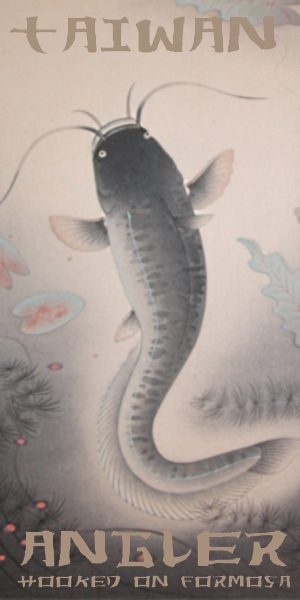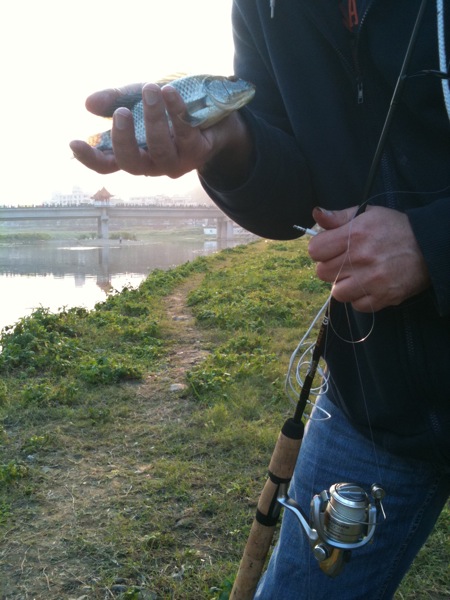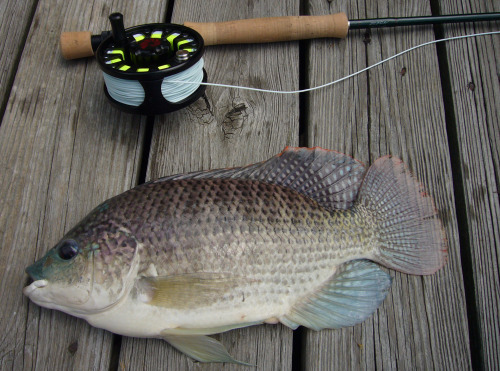Fishing Report: Baoshan Reservoir and Jinji Hu Fishing Pond
 Monday, February 28, 2011 at 2:32PM
Monday, February 28, 2011 at 2:32PM Baoshan Reservoir, Hsinchu County
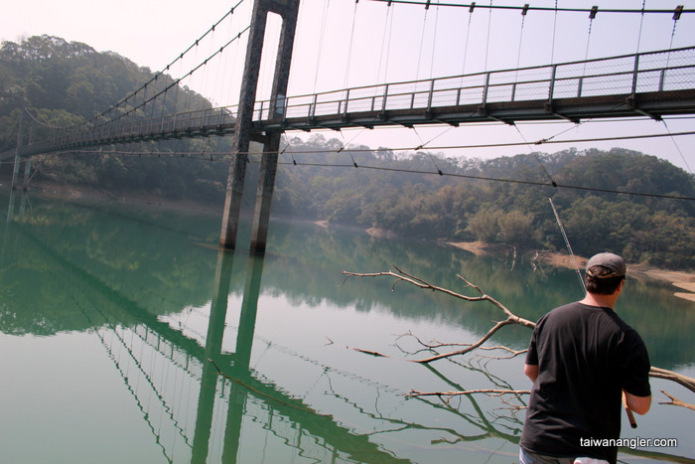 Fishing Baoshan Reservoir near footbridge. No action, but at least the scenery was great.I headed into Hakka country for a little birthday fishing with my friend/coworker Patrick on Sunday. The weather had finally cleared up after nearly two months of chilly, rainy gloom. I had mapped out a few possible destinations and topping that list was Baoshan Reservoir in the foothills of Hsinchu County. It’s a picturesque little lake (not so little by Taiwan standards).
Fishing Baoshan Reservoir near footbridge. No action, but at least the scenery was great.I headed into Hakka country for a little birthday fishing with my friend/coworker Patrick on Sunday. The weather had finally cleared up after nearly two months of chilly, rainy gloom. I had mapped out a few possible destinations and topping that list was Baoshan Reservoir in the foothills of Hsinchu County. It’s a picturesque little lake (not so little by Taiwan standards).
Most of the shoreline is accessed by well-maintained hiking trails, so the area seems to attract more weekend hikers than anglers. However, Baoshan is known to be one of the better fisheries in northern Taiwan for largemouth bass. The lake also supports healthy populations of tilapia, topmouth culter, mud carp and a few other species of carp.
We arrived at the reservoir around 8:30 a.m. and started our fishing near the dam. After an hour or so without any luck, we moved around the lake to the first suspension bridge (there are two pedestrian suspension bridges on the northern arm of the reservoir). We spent the rest of the morning bouncing lures off submerged trees and casting to schools of tilapia, but still no action.
While the fish at Baoshan may not have been cooperating this morning, one couldn’t complain about the setting. The area is lush and green, and teems with wildlife, including one very long snake spotted swimming across the cove. Birds are in abundance—cranes, egrets, herons and at least one pair of eagles. We, however, had come to catch fish, so we decided to pack it in and head for more productive waters.
Jinji Hu Fishing Pond, Pinghjen, Taoyuan County
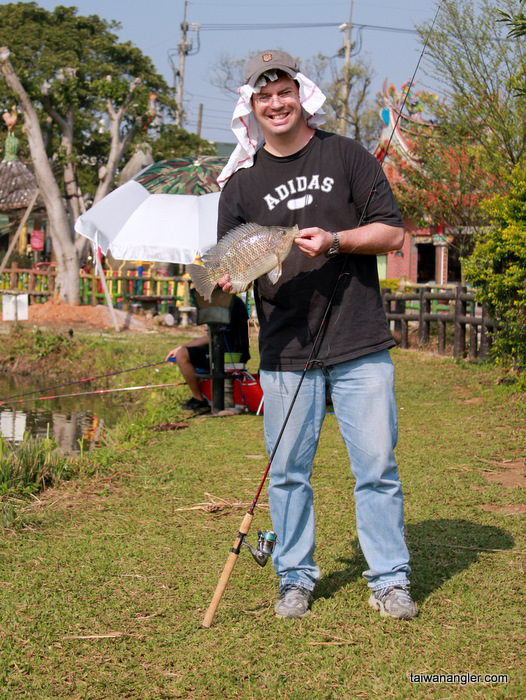 First blood--a nice tilapia.Hoping to improve our chances, Patrick and I headed north to Taoyuan County to try a recreational pond I had read about on a local blog. Jinji Hu Fishing Pond is located on a country road between the townships of Lungtan and Pinghjen (though it is technically in Pinghjen). It is one of the few pay-to-fish ponds I have heard of that stocks largemouth bass and is fairly popular with the handful of local anglers who pursue this foreign import game fish. While most of these recreational ponds are concrete eyesores, Jinji Hu was a pleasant surprise. The area around the ponds is landscaped with grass. There are picnic tables and a shaded area, even a playground for the kids. What was originally a single large pond is now divided into two. Both are stocked with bass and tilapia and a few other species for which the locals only knew the Chinese names.
First blood--a nice tilapia.Hoping to improve our chances, Patrick and I headed north to Taoyuan County to try a recreational pond I had read about on a local blog. Jinji Hu Fishing Pond is located on a country road between the townships of Lungtan and Pinghjen (though it is technically in Pinghjen). It is one of the few pay-to-fish ponds I have heard of that stocks largemouth bass and is fairly popular with the handful of local anglers who pursue this foreign import game fish. While most of these recreational ponds are concrete eyesores, Jinji Hu was a pleasant surprise. The area around the ponds is landscaped with grass. There are picnic tables and a shaded area, even a playground for the kids. What was originally a single large pond is now divided into two. Both are stocked with bass and tilapia and a few other species for which the locals only knew the Chinese names.
A very reasonable NT$300 gets you a whole day of fishing. The caveat is that you can only take home one fish per angler in your group, making it a mostly catch-and-release pond. You also are requested to use barbless hooks or to at least to flatten the barbs on your hooks with pliers. This allows you to return the fish to the water with the least harm to the fish.
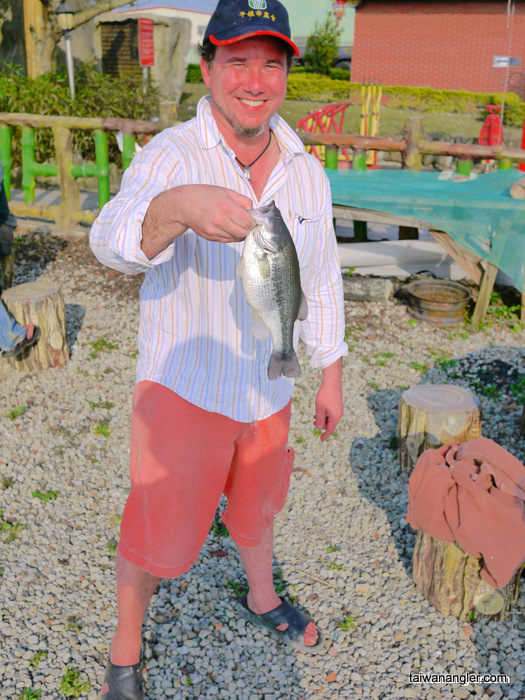 Patrick's first fish in 25 years. That rosy glow is half sunburn and half the result of seven Taiwan Beers.Ponds like this offer anglers a great opportunity to try different tactics and perfect their technique. Most of the bass are on the small side (one to two pounds), but the tilapia are quite large for the species. My first score of the day was a fat tilapia which I foul hooked in the belly (this seems to be a trend with me) with a swim bait. My first bass came after more than an hour of trying different lures and tactics. The bass are quite cagy for a stocked pond. Many have been caught and released more than once and tend to be cautious, particularly in the heat of midday. On several occasions, one or two bass followed my lure, even bumping it with their noses as it rested on the surface, before losing interest.
Patrick's first fish in 25 years. That rosy glow is half sunburn and half the result of seven Taiwan Beers.Ponds like this offer anglers a great opportunity to try different tactics and perfect their technique. Most of the bass are on the small side (one to two pounds), but the tilapia are quite large for the species. My first score of the day was a fat tilapia which I foul hooked in the belly (this seems to be a trend with me) with a swim bait. My first bass came after more than an hour of trying different lures and tactics. The bass are quite cagy for a stocked pond. Many have been caught and released more than once and tend to be cautious, particularly in the heat of midday. On several occasions, one or two bass followed my lure, even bumping it with their noses as it rested on the surface, before losing interest.
Patrick caught his first bass (his first fish in 25 years he later told me), on a small plastic grub and jighead rig. One of the pond’s regulars, Mr. Jiang, advised him to slow his retrieve to a near crawl and the advice paid off with a nice little two-pounder.
We found out later from the pond’s owner that Mr. Jiang is something of a legend in local bass fishing circles. He asked if he could look through my tackle box and then quickly dismissed most of what he found there. A pouch of plastic worms caught his eye and he told me to switch to these and showed me how to rig them “wacky style.” I had been fishing plastics on and off throughout the day rigged both Carolina- and Texas-style. He told me to remove the weight and use a simple #3 hook sunk midway down the length of the worm. It looked odd and was more difficult to cast without the extra weight. Casting distance didn’t really matter, however, since the fish were holding fairly tight up against the banks. He showed me how to work the bait with slow, gentle twitches. The payoff was immediate, and for the next 40 minutes I was hooking up on every three or four casts.
Mr. Jiang turned out to be a regular Jedi master when it came to local fishing lore, hinting that he may guide me to some of his “secret” spots in the future. This is what makes fishing recreational ponds so great—you get to meet and network with other anglers in a way that you probably wouldn’t out on more remote waters. Mr. Tseng, the pond owner, was as friendly as you could hope for and he really lit up when Patrick tried out a little Hakka with him. Pretty soon he was bringing us locally grown bananas, roasted pumpkin seeds and green tea from his private stock. He even offered to repair my rod tip, which I snapped reaching to lip-land a bass.
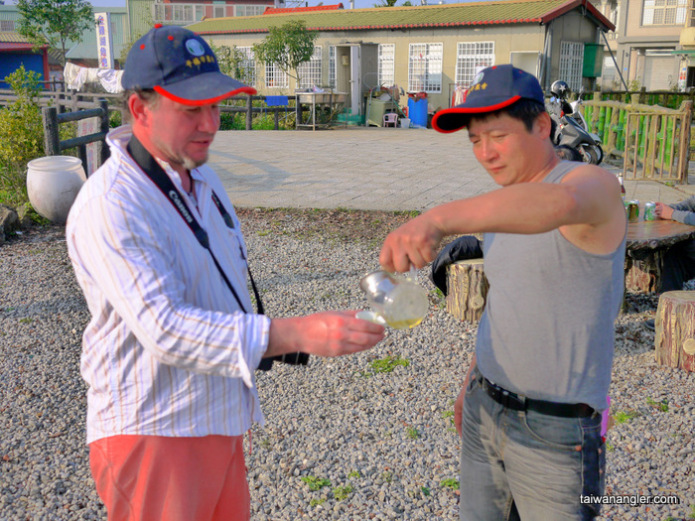 The pond owner, Mr. Tseng, shares some tea and angling wisdom.The pond attracts a nice mix of anglers. There was at least one guy pole fishing with a very typical Taiwanese bait fishing rig—umbrella, bowls of bait mix and chum, pole holder—who seemed to be landing a fat tilapia every five minutes. There were a couple of fly casters who were getting a lot of action on streamer fished along the bank. A fair number of dads had their kids in tow (at least one youngster fell into the pond and had to be fished out). The whole place has a nice family atmosphere and I’ll definitely be bringing the kids along next time.
The pond owner, Mr. Tseng, shares some tea and angling wisdom.The pond attracts a nice mix of anglers. There was at least one guy pole fishing with a very typical Taiwanese bait fishing rig—umbrella, bowls of bait mix and chum, pole holder—who seemed to be landing a fat tilapia every five minutes. There were a couple of fly casters who were getting a lot of action on streamer fished along the bank. A fair number of dads had their kids in tow (at least one youngster fell into the pond and had to be fished out). The whole place has a nice family atmosphere and I’ll definitely be bringing the kids along next time.
 Chris Jackson |
Chris Jackson |  7 Comments |
7 Comments |  1 Reference | | tagged
1 Reference | | tagged  Baoshan Reservoir,
Baoshan Reservoir,  Hsinchu County,
Hsinchu County,  Taoyuan County,
Taoyuan County,  Tilapia,
Tilapia,  largemouth bass,
largemouth bass,  pay ponds in
pay ponds in  Fishing Report
Fishing Report 






